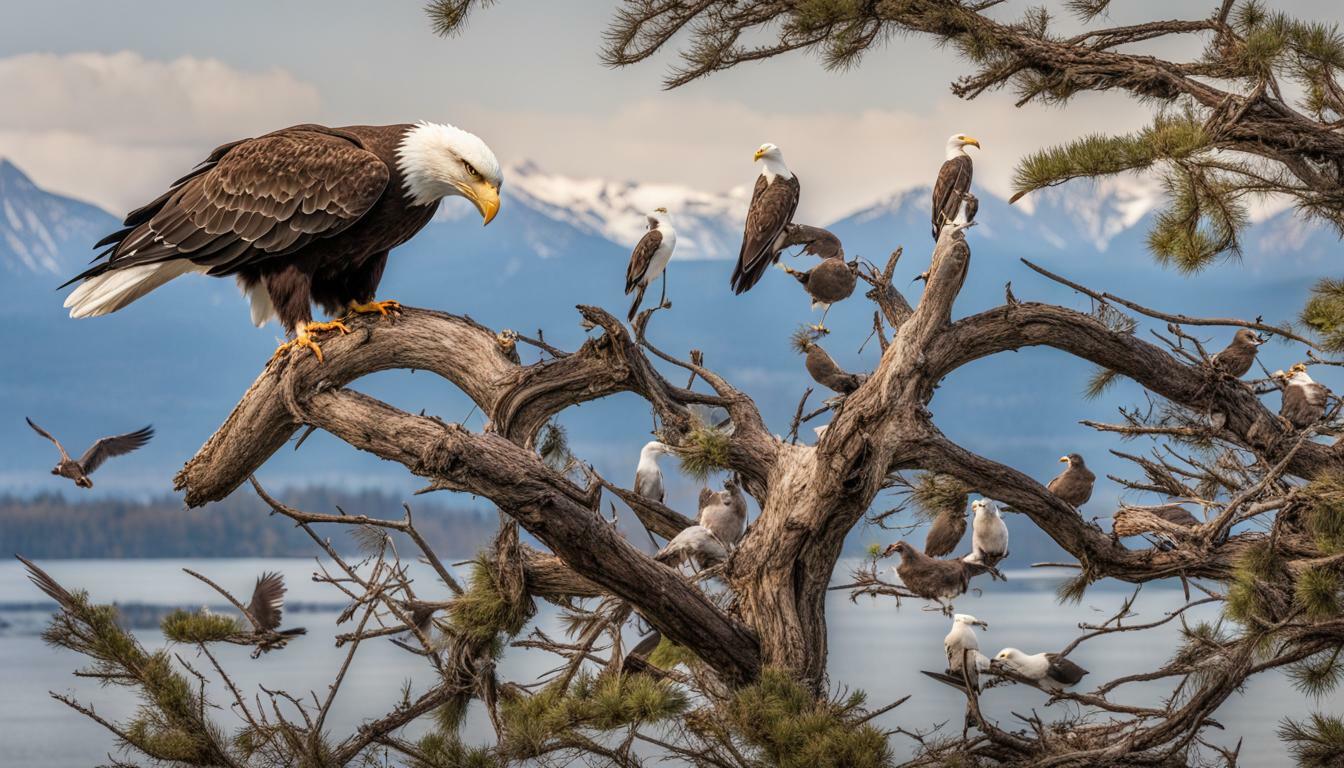Have you ever wondered if bald eagles eat other birds as part of their diet? These majestic birds of prey are known for their impressive hunting skills, but what exactly do they prey on? In this section, we’ll explore the dietary habits of bald eagles and delve into whether or not they consume other bird species.
As one of the largest birds of prey in North America, bald eagles have a varied diet that primarily consists of fish, small mammals, and reptiles. However, they have been known to target other bird species as well, particularly those that are injured or weak.
To gain a better understanding of bald eagles’ diets and hunting habits, let’s take a closer look at their natural predators, food sources, and feeding behavior.
Key Takeaways:
- Bald eagles primarily consume fish, small mammals, and reptiles, but have been known to prey on other bird species as well.
- To understand their dietary habits, we will explore their natural predators, food sources, and feeding behavior.
Bald Eagles’ Natural Predators
If you’re wondering whether bald eagles are preyed upon by other birds, the answer is yes! While bald eagles are apex predators and have few natural predators of their own, they are occasionally targeted by other large birds of prey such as golden eagles and great horned owls.
However, these instances are relatively rare, as bald eagles are known for their impressive size and strength, as well as their sharp talons and powerful beaks, which make them formidable opponents in any fight. In fact, bald eagles have been known to attack and even kill other birds of prey, such as ospreys and hawks, when they believe their territory is being threatened.
| Predator | Prey |
|---|---|
| Golden eagle | Bald eagle |
| Great horned owl | Bald eagle |
Despite their relative dominance in the skies, bald eagles are still vulnerable to certain predators, particularly when they are young and inexperienced. In addition to other birds of prey, bald eagles may also fall prey to larger mammals, such as bears and coyotes, who may attempt to raid their nests for eggs or chicks.
However, overall, bald eagles remain at the top of the food chain, with few natural enemies to worry about. Their impressive hunting skills and adaptability to a range of environments make them a true symbol of American strength and resilience.
Bald Eagles’ Food Sources
As apex predators, bald eagles have a diverse diet that includes a variety of prey species. Their primary food sources are fish and small mammals, but they also consume reptiles and invertebrates. However, do bald eagles eat other birds?
While other avian species are not a major component of bald eagle diets, they do occasionally prey on smaller birds. This is more common during the breeding season when eagles need to provide food for their young and may resort to hunting smaller prey in their vicinity.
Bald eagles are opportunistic hunters and will take advantage of any available food source. They may scavenge on carrion, steal prey from other birds, or hunt live prey. Their diet varies depending on the time of year, location, and availability of prey.
Since bald eagles are found in both marine and terrestrial environments, they have access to a wide range of food sources. In coastal areas, they primarily hunt fish and water birds such as ducks and gulls, while in inland areas, they prey on small mammals like rabbits and squirrels.
Overall, bald eagles have a varied and adaptable diet that allows them to survive in a variety of habitats. While they do occasionally consume other bird species, it is not a significant part of their overall diet.
An Overview of Bald Eagles’ Prey
Bald eagles are opportunistic hunters and will consume a variety of prey species, including fish, small mammals, and reptiles. While these raptors are not known for exclusively preying on other birds, there have been documented cases of bald eagles hunting and consuming avian species.
According to research, the primary source of sustenance for bald eagles is fish. These birds have powerful talons and sharp beaks that allow them to catch and kill fish in freshwater or marine environments. They will also scavenge for fish that have died or been killed by other predators.
When it comes to small mammals, bald eagles have been known to prey on rodents, rabbits, and even other smaller carnivores like raccoons. Their hunting abilities and keen eyesight allow them to target these animals on land or in trees.
| Potential Prey Species for Bald Eagles | Frequency of Consumption |
|---|---|
| Fish | Primary source of sustenance |
| Small mammals | Occasional prey |
| Reptiles | Infrequent prey |
| Other birds | Depends on specific populations and environmental conditions |
As for avian species, bald eagles have been observed targeting waterfowl such as ducks and geese, as well as seabirds like gulls and terns. However, the frequency of bald eagles consuming other birds varies depending on the specific population and environmental conditions.
Overall, while bald eagles primarily rely on fish as their main source of sustenance, they will hunt and consume a range of prey species when necessary. While avian species are not a regular part of their diet, bald eagles have been known to prey on other birds from time to time.
Do Bald Eagles Hunt and Consume Other Birds?
If you’ve ever wondered whether bald eagles eat other birds, you’re not alone. While these raptors are known to have a diverse diet, consisting of fish, small mammals, and reptiles, their relationship with other avian species is less clear.
Research has shown that bald eagles do indeed hunt and consume other birds, though the frequency and significance of this behavior varies depending on factors such as geographic location and seasonality.
“In Alaska, bald eagles have been observed preying on seabirds such as puffins and cormorants, while in Florida they have been seen consuming small songbirds like Eastern Bluebirds and Pine Warblers”
In some cases, bald eagles may target other birds opportunistically, particularly when their primary food sources are scarce. However, in other situations, they may actively seek out avian prey, utilizing their impressive aerial abilities to outmaneuver and capture their targets.
It’s worth noting that while bald eagles are capable of taking down other birds, this behavior is not a regular or significant part of their diet in most areas. Nonetheless, their predation on avian species highlights the complex interplay between different groups of animals in our ecosystems.
Bald Eagles’ Feeding Behavior
When it comes to feeding, bald eagles are efficient hunters that use their keen eyesight and powerful talons to catch prey. Their hunting techniques vary depending on the type of prey they are targeting.
For fish, bald eagles will either plunge dive into the water or grab fish near the surface with their talons. When hunting mammals and reptiles on land, they will soar over open areas looking for movement, then swoop down to catch their prey. When targeting smaller birds, bald eagles will often ambush them from trees or other perches, using their speed and agility to catch them off guard.
Interestingly, bald eagles have been observed stealing food from other birds, including osprey and hawks. They will also scavenge on occasion, feeding on carrion or the remains of other animals.
Despite their ability to catch other birds, research suggests that avian predation is not a significant part of the bald eagle’s diet. Instead, they primarily rely on fish, which can make up over 70% of their diet in coastal areas.
Overall, bald eagles’ feeding behavior is diverse and adaptable. They are able to catch a wide variety of prey, making them successful hunters in many different environments.
Factors Influencing Bald Eagles’ Diets
As with any animal, the diet of bald eagles is influenced by a variety of environmental factors. The abundance and availability of different prey species is a significant factor in determining what they eat. In areas where fish populations are low, for example, bald eagles may turn to other food sources, including small mammals and reptiles.
The time of year also plays a role in their diet. During the winter, when bodies of water freeze over, bald eagles may have to rely more heavily on land-based prey such as rabbits and squirrels.
Environmental conditions such as weather patterns and habitat destruction can also have an impact on bald eagle diets. Changes in water temperature and weather patterns can affect the availability of fish, while habitat destruction can lead to declines in prey species populations.
In addition to these external factors, bald eagles may also exhibit individual dietary preferences. Some eagles may have a particular affinity for certain types of prey, while others may be less selective in their diet.
Overall, the diet of bald eagles is a complex and ever-changing phenomenon that is influenced by a range of internal and external factors. By understanding these factors, we can gain a better appreciation for the feeding habits of these remarkable birds.
Bald Eagles vs. Birds of Prey
If you’re interested in the eating habits of birds of prey, you may be wondering how bald eagles compare to other raptors like hawks and owls. While bald eagles are known to prey on a wide variety of animals, including fish, small mammals, and reptiles, their consumption of other birds sets them apart from many other raptors.
Unlike some species of hawks and owls, which primarily target small mammals and insects, bald eagles have been observed hunting and consuming a range of bird species. This includes waterfowl like ducks and geese, as well as smaller birds like gulls and crows.
However, it’s important to note that eagles do not exclusively prey on other birds. They are opportunistic hunters and will consume whatever prey is available to them. Additionally, while bald eagles have the ability to fly at high speeds and catch small birds in midair, they are not as agile in flight as other raptors like falcons, which are known for their impressive aerial hunting skills.
Unique or common among raptors?
So, is the predation of other birds unique to bald eagles, or is it common among raptors in general? The answer is somewhat complex.
While many raptors do consume other bird species as part of their diet, the frequency and significance of avian predation varies widely depending on the species and location. Some raptors, like the peregrine falcon, are known for their exceptional bird-hunting abilities, while others may rarely consume other birds.
Ultimately, the eating habits of raptors are shaped by a variety of factors, including their physical capabilities, the availability of prey species, and their natural environment. As such, the predation of other birds by bald eagles is not necessarily unique, but it is a significant part of their dietary habits.
Conclusion
After exploring the diets of bald eagles, we can confidently answer the question of whether they eat other birds. While bald eagles are known for their preference for fish, they do occasionally hunt and consume other bird species. However, observations and scientific research suggest that avian predation is not a significant part of their diet.
It is clear that bald eagles rely on a variety of food sources to meet their nutritional requirements. Marine environments, in particular, play a vital role in providing sustenance for these magnificent birds of prey. Small mammals, reptiles, and fish are also important parts of their diet.
The feeding behavior of bald eagles is fascinating, and their hunting techniques are often specific to different types of prey. While they are skilled hunters, they do face threats from natural predators, such as bears and other birds of prey.
Overall, our exploration of bald eagle diets has provided valuable insights into their relationship with other avian species. While they do occasionally hunt and consume other birds, this is not a significant part of their diet. It is clear that their eating habits are shaped by a variety of factors, including the availability of different prey species and environmental conditions.
What Types of Birds Do Bald Eagles Typically Eat?
Bald eagles’ diet includes smaller birds. Their prey primarily consists of fish, but these majestic birds are known to diversify their menu. They also feed on waterfowl, such as ducks and geese, as well as small mammals like rabbits and squirrels. However, bald eagles’ preference for fish remains unmatched in their hunting habits.
FAQ
Q: Do bald eagles eat other birds?
A: Yes, bald eagles do eat other birds as part of their diet. They are opportunistic hunters and will prey on a variety of avian species, including waterfowl, seabirds, and smaller birds.
Q: What are the natural predators of bald eagles?
A: While bald eagles are apex predators, they do have some natural predators. These may include larger birds of prey such as golden eagles and great horned owls. However, predation on bald eagles is relatively rare.
Q: What are the food sources for bald eagles?
A: Bald eagles rely on a diverse range of food sources to meet their dietary needs. These include fish, mammals like rabbits and squirrels, reptiles, and even carrion. However, they primarily feed on fish, especially during the breeding season.
Q: What types of prey do bald eagles typically target?
A: Bald eagles commonly target fish as their primary prey. They are skilled hunters and have been known to catch fish from both freshwater and marine environments. However, they also prey on small mammals and reptiles.
Q: Do bald eagles actively hunt and consume other bird species?
A: Yes, bald eagles do actively hunt and consume other bird species. While fish make up the majority of their diet, they will opportunistically prey on smaller birds, waterfowl, and seabirds when given the chance.
Q: How do bald eagles locate, catch, and consume their prey?
A: Bald eagles use their keen eyesight to locate potential prey, especially fish swimming near the water’s surface. They will swoop down, grab the prey with their talons, and carry it away to a perching spot where they can consume it at their leisure.
Q: What factors influence the diet of bald eagles?
A: The diet of bald eagles is influenced by various factors, including the availability and abundance of different prey species. Environmental conditions, such as the freezing of bodies of water, can also impact their food choices.
Q: How do bald eagle diets compare to other birds of prey?
A: The diet of bald eagles differs from other birds of prey in some aspects. While they do prey on other birds, their primary source of food is fish. In comparison, species like hawks and owls may rely more heavily on small mammals and birds.











